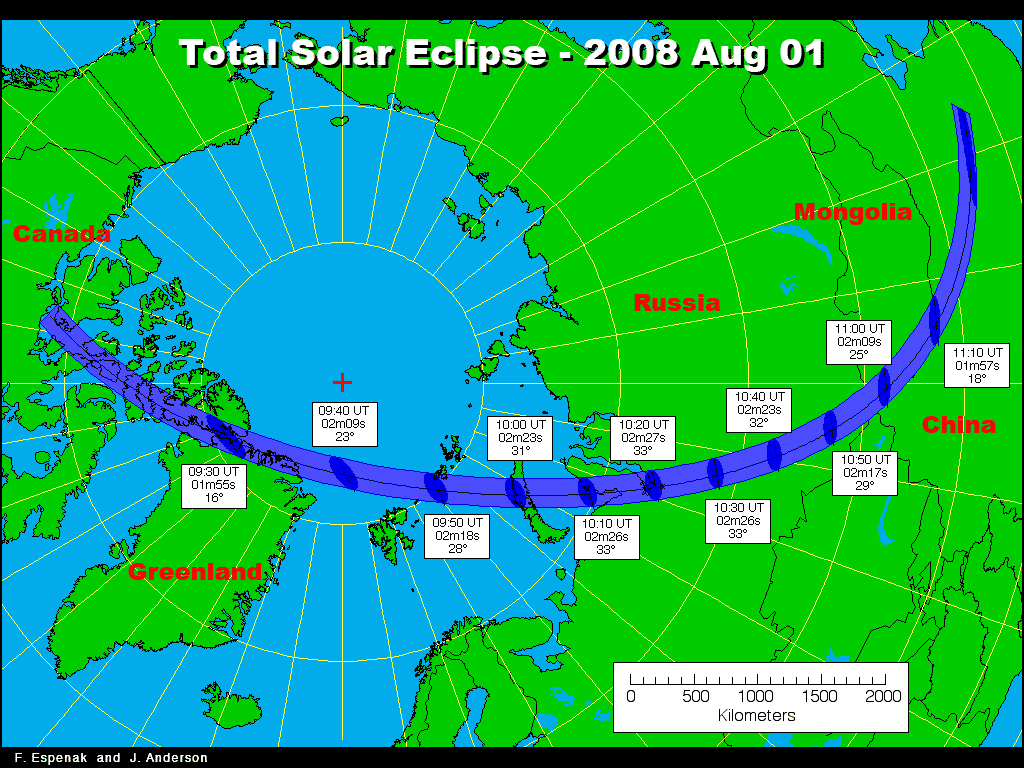Solar Eclipse Friday to Fascinate Millions

A total eclipse of the sun Friday should fascinate millions of lucky skywatchers in Greenland, Siberia, Mongolia and China.
If the weather cooperates, people along a narrow path who venture out and look up will see stars during the day as the sun is gradually devoured and ultimately blotted out by the moon.
Unlike ancient times, when eclipses were viewed as bad omens in many cultures, fewer people should be expecting doom this time around. Still, myths persist, especially in remote regions, so it's likely there will be some banging on pots and other creative tactics employed to drive the "evil spirits" away.
Billions of people along the path, including most of Europe and Asia, have a chance to see an interesting but much less foreboding partial eclipse. The northern half of Maine and the Canadian Maritime Provinces will be graced with a partial eclipse at sunrise.
Myth and mystery
Solar eclipses occur when the moon moves in front of the sun. This can happen only at the time of a new moon, when the moon is between Earth and the sun. When the three objects align perfectly an eclipse occurs.
Before there was a scientific explanation for eclipses, myth and mystery was pervasive.
Breaking space news, the latest updates on rocket launches, skywatching events and more!
Many cultures thought a demon or dragon was devouring the sun.
In ancient China, "any unusual phenomenon involving celestial bodies was noted for potential omens, either good or bad, that might befall the current Emperor," according to Sten Odenwald of the department of physics at Catholic University. An eclipse occurred in 2134 B.C., but was not predicted by Hsi and Ho, who were believed to have been two astrologers who served the Emperor Chung K'ang.
"By some accounts, the two astrologers were negligent in their duties and did not foretell the event for the Emperor," Odenwald writes in a historical article published by NASA. "They were summarily beheaded for their negligence of duty."
The ancient Chinese banged pots and drums to shoo the frightful sun-eating character away, according to the Exploratorium Science Center in San Francisco. In India, people would immerse themselves in water to help the sun fight the dragon.
Even nowadays many myths persist. In Egypt, as one example, children are often kept indoors with windows covered or shades drawn during an eclipse.
Prior to a total solar eclipse in 2006, one Indian paper advised pregnant women not to go outside during the eclipse to avoid having a blind baby or one with a cleft lip. Food cooked before the eclipse was to be thrown out afterward because it would be impure and those who are holding a knife or ax during the eclipse would cut themselves, the Hindustan Times added.
In Togo, authorities prior to the 2006 solar eclipse called on villagers to stay home. "Please, do not go out and keep your children indoors on solar eclipse day,'' Togo's minister for health said in a message broadcast on state television.
Risk of eye injury
Eclipses can indeed be dangerous.
Despite myths and rumors, a total solar eclipse is safe to watch during the darkness of totality, when no rays of the sun are passing to your eyes. The corona, or atmosphere of the sun, is often partly visible when the moon blocks out the main disk of the sun. Viewing the corona during totality also is safe.
However, looking directly at the sun, even during a partial eclipse, will damage your eyes unless you wear proper eye protection. It is extremely dangerous to eyesight to look directly at an eclipse at any stage expect during totality.
Glasses designed specifically for eclipse viewing are recommended, or a handful of indirect viewing methods can be used:
With masking tape, cover all but a 1/2-inch square of a small mirror. Project the sun onto a shaded wall. Or with a pencil, poke a small hole in a piece of paper. Let sunlight fall trough the hole onto a second sheet of white paper about a foot below.
Webcast planned
For those not fortunate enough to be in the eclipse's narrow path, a live webcast is planned.
NASA, in partnership with the Exploratorium and the University of California, Berkeley, will transmit live images on NASA TV. The coverage, originating in China and reliant on good weather, runs from 6 a.m. to 8:15 a.m. ET.
The period of total eclipse, or totality, will occur from 7:08 a.m. to 7:10 a.m. ET.
- The Science Behind the Eclipse
- Galleries: Solar Eclipse in 2005 and 2006
- Viewer's Guide to the Aug. 1 Solar Eclipse

Rob has been producing internet content since the mid-1990s. He was a writer, editor and Director of Site Operations at Space.com starting in 1999. He served as Managing Editor of LiveScience since its launch in 2004. He then oversaw news operations for the Space.com's then-parent company TechMediaNetwork's growing suite of technology, science and business news sites. Prior to joining the company, Rob was an editor at The Star-Ledger in New Jersey. He has a journalism degree from Humboldt State University in California, is an author and also writes for Medium.
